Road Test: 2013 Mini John Cooper Works Convertible
Story and photos by John LeBlanc
Ever since the early ’70s, small cars have been seen as cheap and low quality — the bottom feeders of the market. The thinking was that small car buyers didn’t have the coin to buy the “whole” car. But that all changed in 2002, when Germany’s BMW launched the “premium small car” with the modern Mini Cooper and the subsequent Convertible.
With its BMW 3 Series-sourced rear suspension and turbocharged engines, the modern Mini on a twisty road would shame cars costing three times its price. And no other car in its class has as much safety kit or in-car-entertainment choices or possibility to customize.Which brings us to the Mini John Cooper Works Convertible. With a $42,900 base price, it’s the most expensive Mini convertible you can buy. In addition, my press fleet loaner was equipped with $6,365 worth of options (including a navigation system and upgraded leather seating), bringing its price up to a not-so-mini $50,920, including a $1,655 freight and pre-delivery inspection fee.
For that big-car price, the Mini JCW Convertible offers a lot of big-car features and performance but that kind of money can also buy you larger, faster, and more comfortable open-top cars like the Mini’s corporate cousin, the rear-wheel-drive BMW 128i Cabriolet; however, the Mini JCW Convertible is truly unique, with its only true competitor the Fiat 500 Abarth Cabrio, which starts at about $15,000 less.
Before we get to the Mini JCW Convertible’s rip-roaring driving personality, you’ll have to decide if you and your lifestyle can fit in the car’s cosy confines. Because it’s not as tall as the Fiat, the Mini’s cabin is fractionally smaller overall, and like any Mini Cooper, rear seat legroom is virtually non-existent, made worse in the Convertible because of the upright nature of the rear seatbacks due to its folding roof apparatus.
Don’t think you’ll be able to make a trip to Ikea and bring home more than a set of cutlery. The Mini JCW Convertible’s spec sheet says there are 660 litres of rear trunk space (four more than the Fiat), but you’ll want to test the size of the mail-box-sized bottom-hinged, rear tailgate opening before signing on the dotted line.
The other issue you’ll want to address is the Mini JCW Convertible’s interior “character.” Since it was introduced in 2002, the Mini’s retro cabin design has garnered plenty of love and hate. We’ve seen some spy shots of the interior of the next-generation Mini Cooper (due to arrive as a two-door hatchback first this fall) and some of the current model’s cartoonish design elements (like the plate-sized, centrally mounted speedometer) will be dropped for more conventional ergonomics.
You do feel some of the Mini JCW Convertible’s premium pricing in day-to-day use, though. While busy in its design, the interior plastics used are of a higher quality than in the Fiat. Steering wheel and driver seat adjustments feel more robust as well. The Mini’s powered convertible top (which can be partially powered back to act like a large sunroof) is a proper piece of mechanical engineering. And while you’ll want to try the tight-fitting front buckets on for size first, they sport finely tailored stitching and plenty of support.
Support for what? you may be asking. Well, while you can carp about the Mini JCW Convertible’s big price tag, it certainly delivers the goods as a driver’s car. On paper, the Mini JCW Convertible simply delivers more than the Fiat 500 Abarth Cabrio.With 208 horsepower and 192 lb.-ft. of torque, the JCW Convertible’s turbocharged 1.6-litre four-cylinder gas engine handily beats the 500 Abarth Cabrio’s 160 hp and 170 lb.-ft. from its blown 1.4-litre gas-four. While fuel economy is not a priority with this customer base, the more manic Mini offers similar fuel economy estimates as the less frothy Fiat: 7.7 L/100 km in the city and 5.6 on the highway, compared to 7.1 and 5.7, respectively. In my week with the JCW Convertible, I saw an average of 7.8 L/100 km.In a straight-line, the Mini’s 0-100 km/h time of 6.3 seconds is nearly a full second quicker than the Fiat.
In day-to-day traffic, the JCW Convertible’s extra torque also means you don’t have to use its six-speed manual gearbox as much as you would think, with plenty of torque available below its 6,500 rpm redline.For more than a decade, BMW’s been promoting the modern Mini as a go-kart, and except for the hardtop JCW model and topline Mini JCW GP, this convertible best exemplifies that ethos.Whether its top is up or down, the Mini JCW Convertible is a joy to drive quickly. Its six-speed manual is slick in shifting gears. I particularly like its steering, which offers laser-like precision, proper weighting off-centre and little kick-back from road irregularities. A close second to the steering is the Mini’s nice balance between its so-called “go-kart” handling and comfortable ride. Mini engineers have been working hard at making the JCW models less stiff than previous attempts, and the latest models can handle rough roads with more aplomb than their bone-crunching predecessors.
That said, the Mini JCW Convertible is no parade float. With a suspension that’s lower and stiffer than lesser Minis, the car resolutely resists the desire to roll in tight turns. And with its phalanx of electronic driving aids, the Mini can make you forget it’s a front-driver only, giving the driver the ability to throw its tail out in turns when prompted.
Of course, when you’re driving the Mini JCW Convertible like a go-kart, the car will let you and everyone within a block or two know. Its exhaust has been turned up to 11, raising the hair on the back of your neck as it farts and barks in almost any gear. It sounds even louder when you have the Mini’s roof pulled down.
If your wallet is thick enough to handle the Mini JCW Convertible’s large entry fee, there’s little on the market that offers so much fun in such a small package.Yes, the car can be noisy at times. And its passenger and cargo room virtually make the car a two-seat roadster. For urban, open air driving enthusiasts, though, the JCW Convertible offers upscale features, build quality and performance to help justify its price premium over the less powerful and less substantial-feeling Fiat 500 Abarth Cabrio rival.
Road Test: 2013 Mini John Cooper Works Convertible
WHAT I LIKED: Mini’s top-performing open-top car; telepathic steering; substantial-feeling throughout.
WHAT I DIDN’T: Price-versus-size ratio; cosy interior; noisy cabin
Base price/as-tested: $42,900/$50,920
Type of vehicle: FWD, four-passenger convertible
Engines: 1.6L, 16-valve, DOHC I-4 turbocharged
Power/Torque: 208 hp / 192 lb.-ft.
Transmission: Six-speed manual
Fuel consumption (city/hwy/as-tested): 7.7 / 5.6 / 7.8 L/100 km
Competition: BMW 128i Cabriolet, Fiat 500 Abarth Cabrio





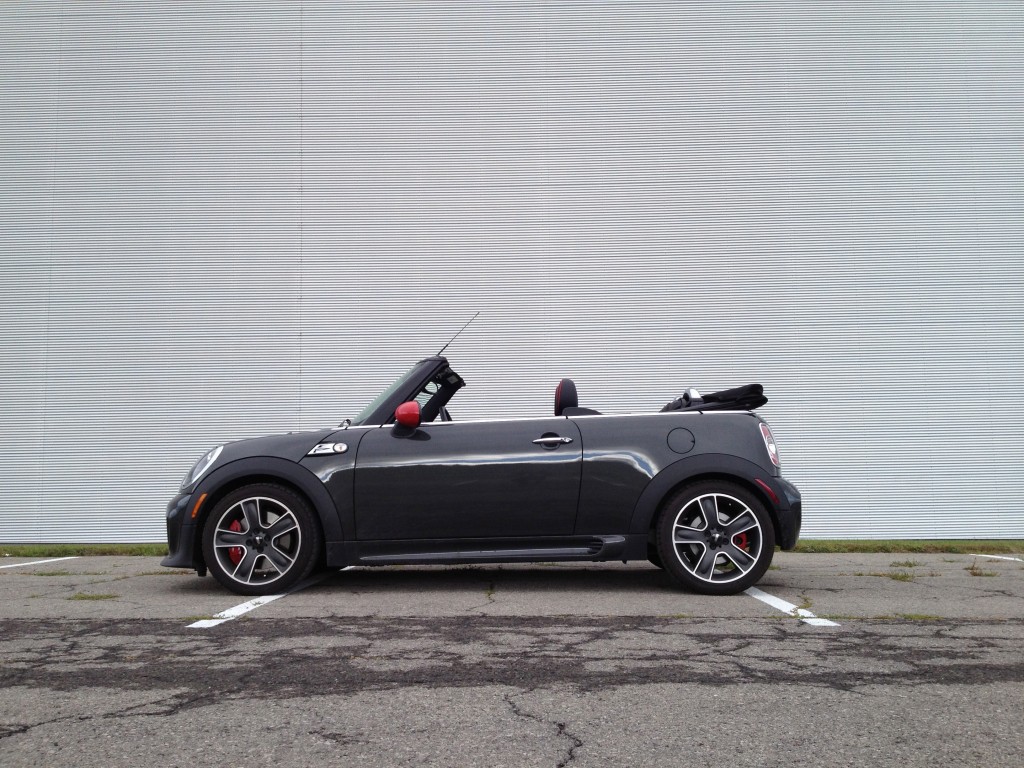
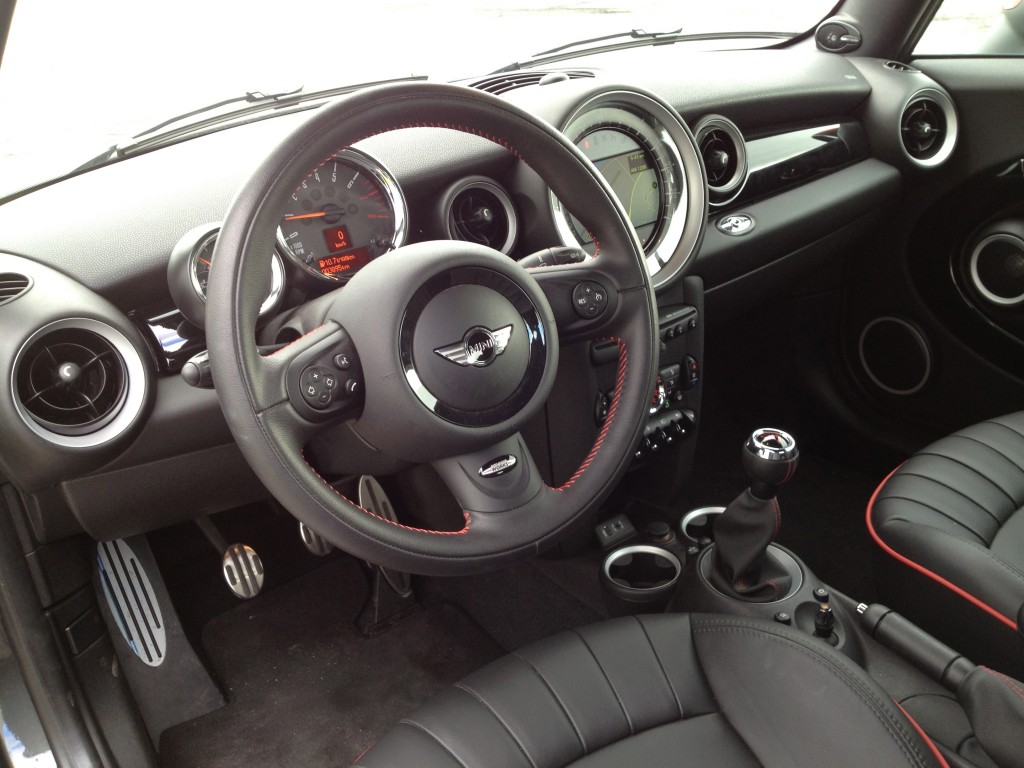
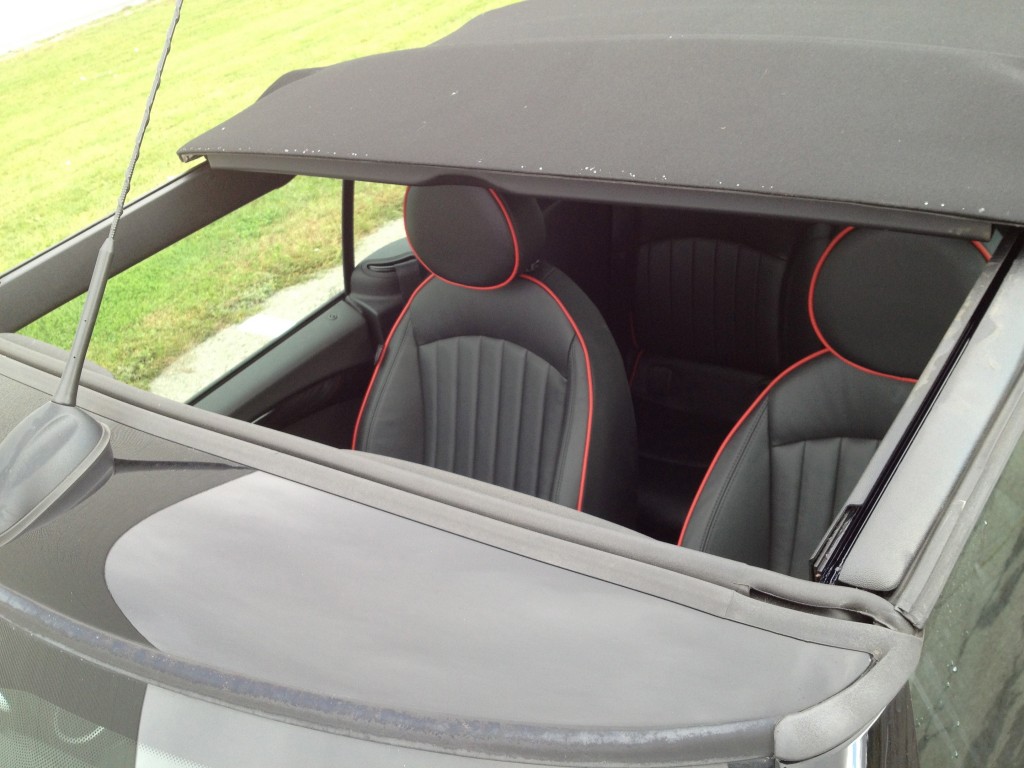
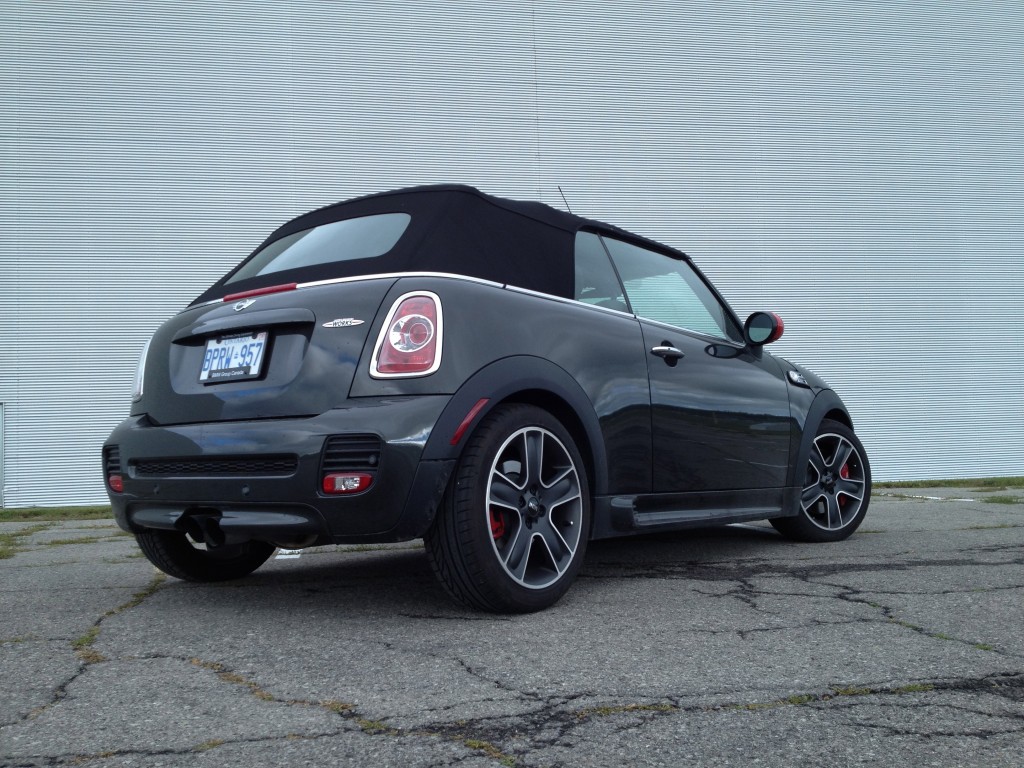
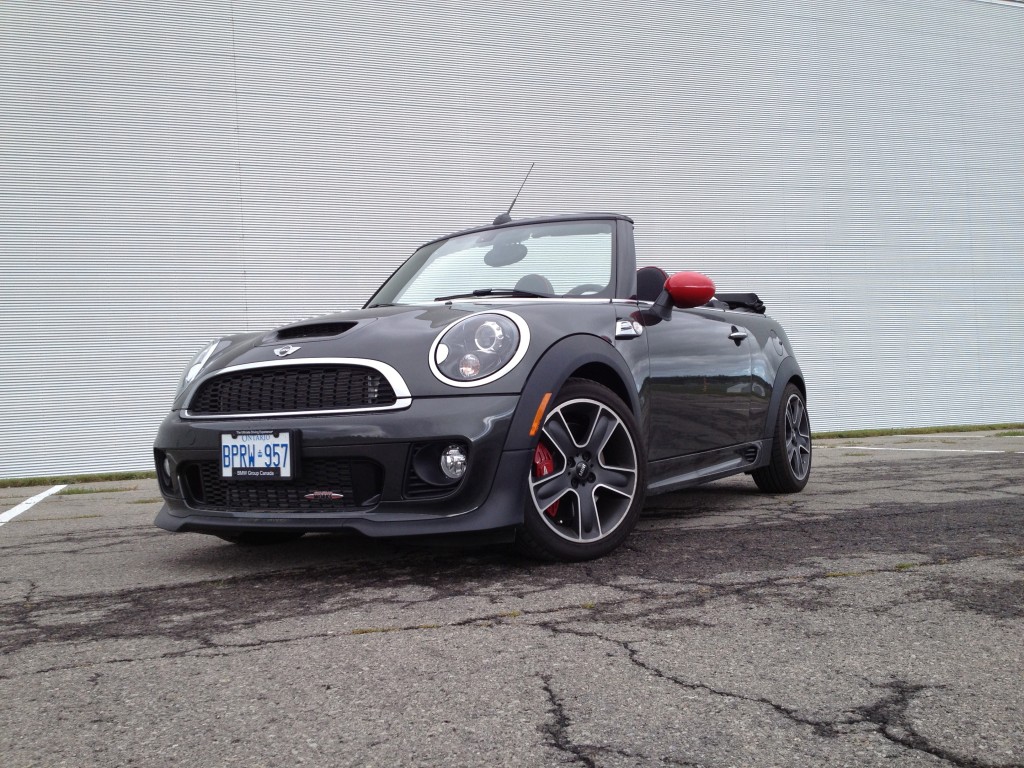
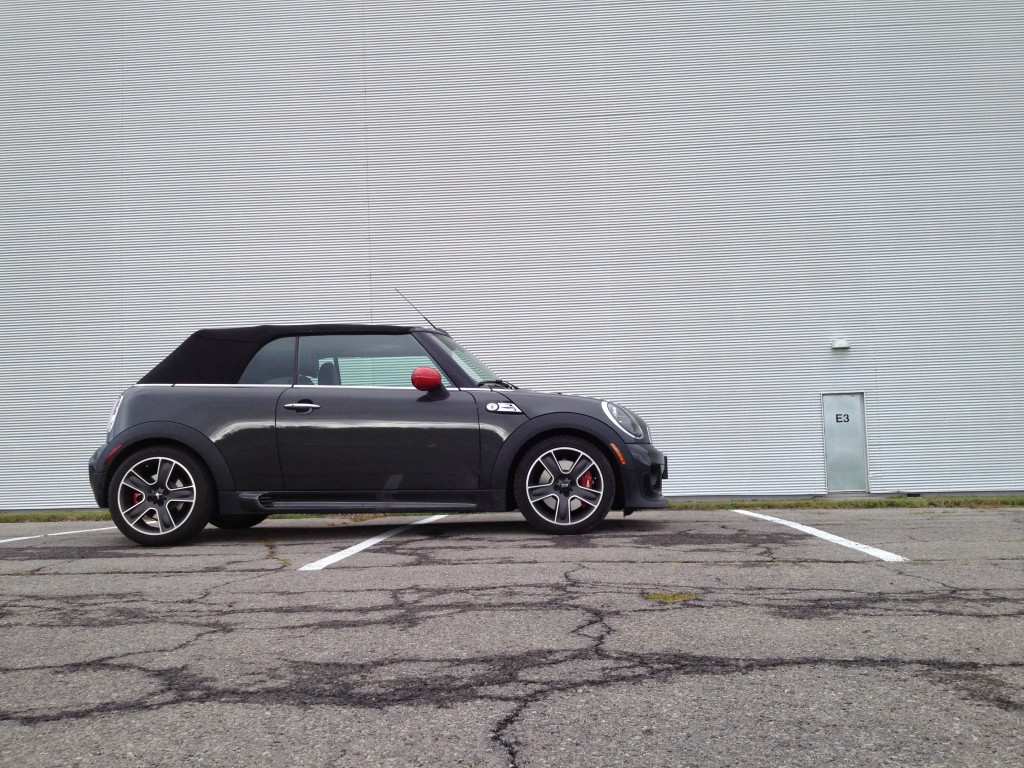
![[del.icio.us]](https://www.straight-six.com/wp-content/plugins/bookmarkify/delicious.png)
![[Digg]](https://www.straight-six.com/wp-content/plugins/bookmarkify/digg.png)
![[Facebook]](https://www.straight-six.com/wp-content/plugins/bookmarkify/facebook.png)
![[Google]](https://www.straight-six.com/wp-content/plugins/bookmarkify/google.png)
![[Reddit]](https://www.straight-six.com/wp-content/plugins/bookmarkify/reddit.png)
![[StumbleUpon]](https://www.straight-six.com/wp-content/plugins/bookmarkify/stumbleupon.png)
![[Twitter]](https://www.straight-six.com/wp-content/plugins/bookmarkify/twitter.png)
![[Email]](https://www.straight-six.com/wp-content/plugins/bookmarkify/email.png)